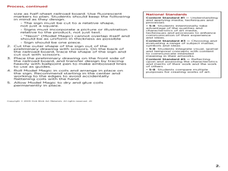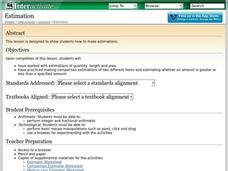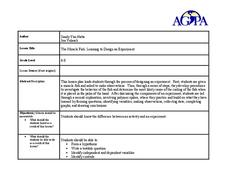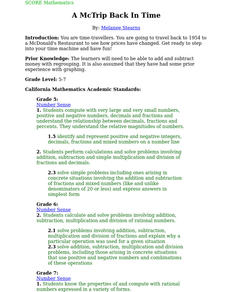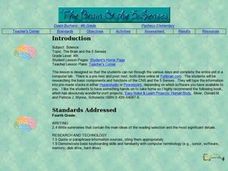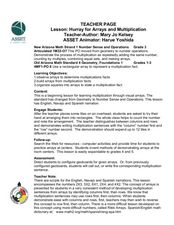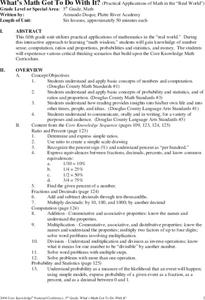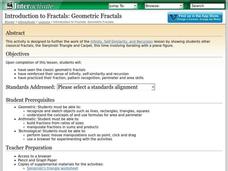Lincoln Public Schools
Cell Exploration Activities
Engage young biologists in exploring the mysteries of life with this collection of hands-on activities. Enlisting the help of numerous digital resources, students get an up-close look at the structure of plant and animal...
Reed Novel Studies
Runaway Ralph: Novel Study
Maybe the grass isn't always greener on the other side. Ralph, a mouse character in Runaway Ralph, thought that summer camp had to be better than dealing with his mother, uncle, and cousins. However, camp has its troubles, too. Worksheet...
Curated OER
Character Bust: Ceramics Lesson
Whether it is a protagonist, antagonist, hero or heroine, characters are a must in any story. Learners analyze a character from a narrative they are reading, then use that character as inspiration. They create a ceramic bust depicting...
Statistics Education Web
Sampling in Archaeology
Compare different random sampling types using an archaeological setting. Scholars collect data from an archaeological plot using simple random samples, stratified random samples, systematic random samples, and cluster random samples....
Statistics Education Web
Text Messaging is Time Consuming! What Gives?
The more you text, the less you study. Have classes test this hypothesis or another question related to text messages. Using real data, learners use technology to create a scatter plot and calculate a regression line. They create a dot...
Statistics Education Web
The Case of the Careless Zookeeper
Herbivores and carnivores just don't get along. Using a box of animal crackers, classes collect data about the injury status of herbivores and carnivores in the box. They complete the process of chi-square testing on the data from...
Chicago Botanic Garden
Recognizing Change (Observation vs. Inference)
What is the difference between making inferences and making observations? Young climatologists refer to a PowerPoint to make observations on each slide. They record their observations in a provided worksheet before drawing a...
Curated OER
Opposite Grapevines
There are really only four basic moves in this line dance. Those dance moves are: grapevine, slide, marching, and then dipping and clapping. Each 8-count is repeated twice, for a total of a 64-count dance. The unique addition to this...
Curated OER
Neon Signs
Middle schoolers study a commercial art form and explore its historic and social meaning. They apply linear color to a shape, bending and forming the lines in much the same way a sign artist would form glass tubing. They design their own...
Curated OER
Estimation
Students explore the concept of estimation. In this estimation lesson, students discuss making estimates through teacher led discussion. Students use the Internet to complete an activity where they must estimate the length of lines.
Curated OER
Observations and Inferences
Students observe how to distinguish observations form inferences. In this examining inferences lesson plan students list observations relating to the activity and discuss the importance of them.
Curated OER
The Miracle Fish: Learning to Design an Experiment
Young scholars develop procedures to explore the behavior of fish. In this scientific experiment lesson students from a hypothesis, write a question, identify different variables and controls in their experiment.
Curated OER
A McTrip Back In Time
Students pretend they are time-travellers and travel back to 1954 to a McDonald's Restaurant to see how prices have changed. They need to add and subtract money with regrouping.
Curated OER
U.S. History: Our Constitutional Amendments
Eighth graders conduct Internet research about Constitutional Amendments and present oral reports on their findings. Their reports also include visual representations depicting their chosen amendment's focal point. Students discuss the...
Curated OER
Patchwork Math
Students recognize and identify shapes in their environment. They investigate why objects can be composed of several different shapes. They follow a pattern to recreate designs using various shapes.
Curated OER
Ratios (Cost of a Habit)
Students consider an individual habit and its cost. They study ratios and proportions, and use that knowledge to calculate the cost of a habit over extended periods of time. write a detailed comparison of the costs.
Curated OER
Hurray for Arrays and Multiplication
Third graders begin learning about multiplication using arrays. In this multiplication with arrays activity, 3rd graders interact with tiles on the overhead as they follow the teacher in making arrays. They write multiplication sentences...
Curated OER
A Toast to Our Community
Students bake bread with a dual purpose: to explore, through the metaphor of baking bread, the potential dynamics and purposes of a classroom, and to begin investigating the idea that everyday things are connected to the local/global...
Curated OER
Hybrid Vehicles: Cut Pollution and Save Money
Young scholars examine how driving a hybrid car can save money and cut down on pollution. In this hybrid vehicles lesson students complete an exercise that shows them how to work with proportions, percents, dimensional analysis and...
Curated OER
Geometry: Area Project
Sixth graders identify and use area formulas for finding the area of geometric shapes.
Curated OER
What's Math Got To Do With It?
Students explore numbers, computation, ratios, proportions, probabilities, statistics, and money in this six lessons unit. Practical applications in the real world are emphasized through an interactive approach to math in these lessons.
Curated OER
Introduction to Fractals: Geometric Fractals
Students explore the concept of fractals. In this fractals lesson, students discuss Sierpinski's Triangle using an applet. Students discuss the patterns involved with fractals. Students discuss the area of Sierpinski's triangle as the...
Curated OER
More Lizard Snacks
Students listen to Chapter I, Chapter II, Chapter III, and Chapter IV of "The Forgetful Pony". They observe different stages of development of mealworms. The student sequences pictures to show the life cycle and draws the developmental...
Curated OER
Reading Trees: Understanding Dendrochronology
Students examine tree-ring dating and discuss the lack of water the settlers in Jamestown faced. They create paper tree rings, simulate rain patterns, and describe the history of construction paper tree sequences.








